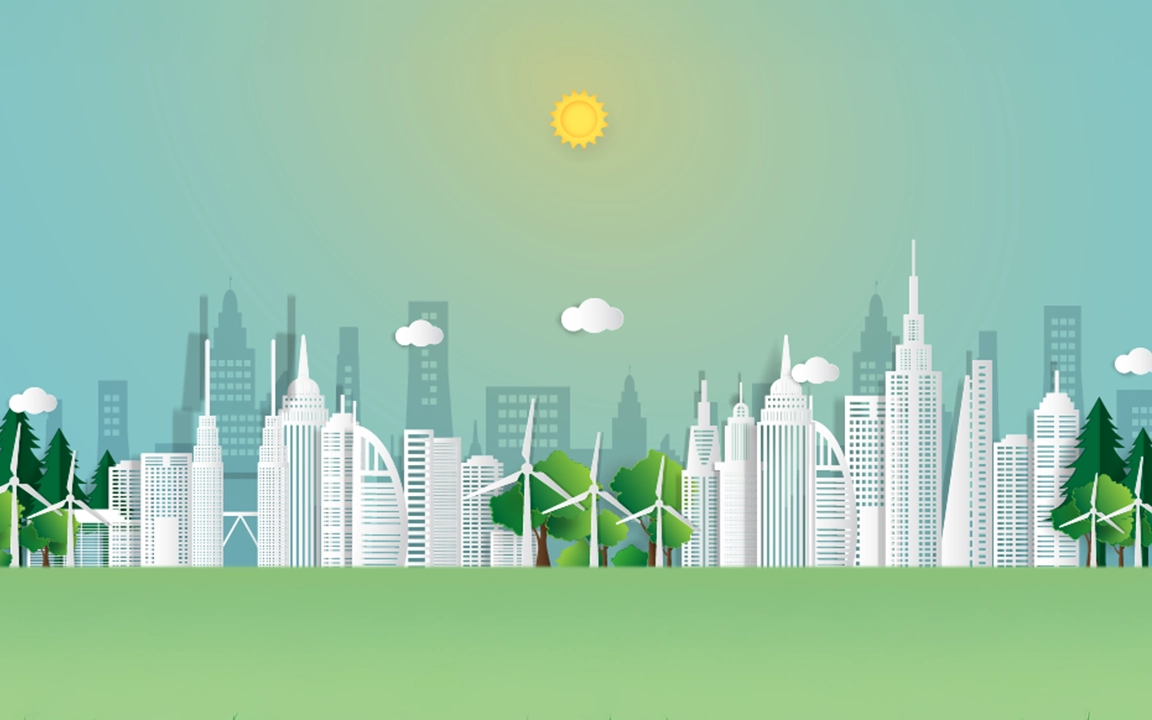A New Era of Energy Part 2: Powering the Future with the Optimal Energy Mix

Click here to read the first article in the series.
In recent years, the world has turned increasing attention toward the sources of energy that power our societies — and for good reason. The large quantities of carbon dioxide (CO2) trapped in our atmosphere is what causes climate change, and we already know that the way we produce and consume energy is a major source of CO2 emissions. But as extreme weather events become more common and we find ourselves facing an ongoing energy crisis, it is clear why there is a heightened sense of urgency when it comes to creating and implementing systems that can meet our power needs without worsening the climate situation.
Energy is a key driver of economic growth and development. As such, many have expressed concerns that the green energy transition will require great sacrifices in economic development and standard of living. However, the International Energy Agency’s (IEA) scenario Net Zero by 2050: A Roadmap for the Global Energy Sector shows that while massive change is required, there’s no need to backtrack on societal progress in order to move forward with renewables. According to the net zero pathway outlined in the report, global energy in 2050 could fall 8% compared to today’s numbers, while serving an economy over twice as big with 2 billion more people. Behavioral changes, efficient energy use, and tapping into resource efficiency can converge to offset growing energy demand as the economy rebounds and green energy access is extended.
While newly-introduced policies such as Europe’s REPowerEU and the United States’ Inflation Reduction Act (IRA) have spurred a series of investments in the green energy sphere, we must recognize that the nature of this transition is multi-faceted. Therefore, interventions driving the energy transition forward require time, collaboration, and an energy mix that reflects a wide range of geographic needs while taking advantage of the resources and technologies available to us. The good news is that momentum is growing by the day, setting the optimal energy mix flywheel in motion. In this feature, we’ll take a closer look at the energy mix, the different types of energy sources in its makeup, and how they can all work together in a net-zero world.
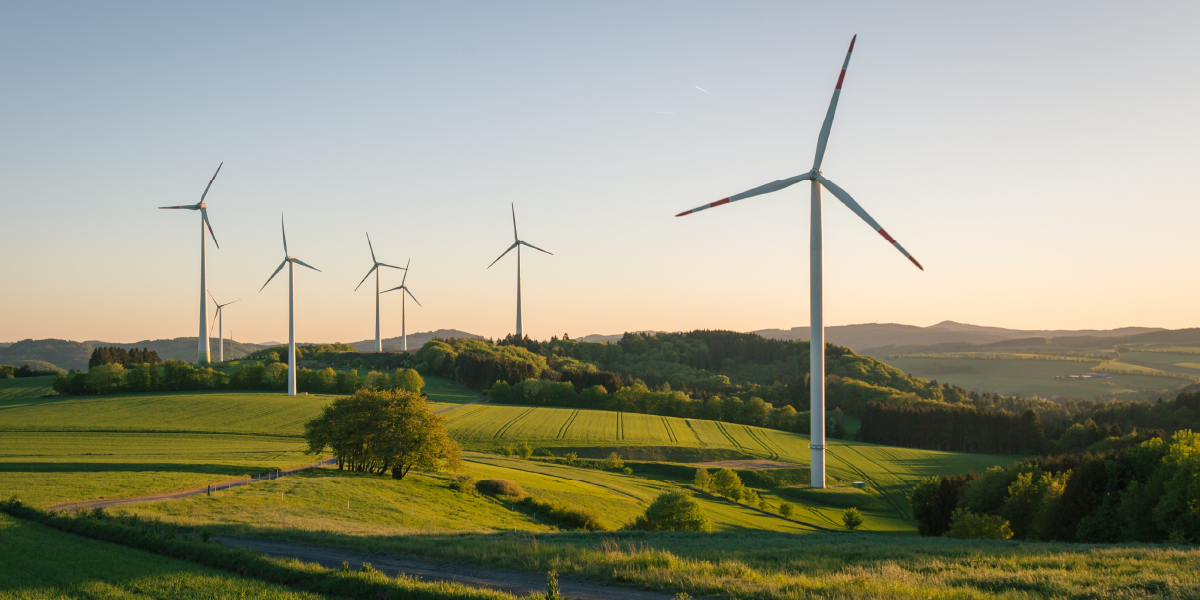
Exploring the Energy Mix
The global energy mix is just as vast and diverse as the globe it powers. The United Nations Economic and Social Commission for Western Asia (UN ESCWA) defines it as the way we use the energy available to us in different proportions in order to meet our energy needs. The energy mix is typically reported by country, and refers to how the final energy consumption in a given geographical region is broken down by primary energy source such as fossil fuels, nuclear energy, waste, and renewables including biomass, wind, geothermal, hydro, and solar. The energy derived from these sources is used to generate electricity, power transportation, heat and cool buildings, and more.
Today, the global energy mix is still dominated by fossil fuels. In fact, they account for more than 80% of energy consumption worldwide. To break it down further, the world currently gets the largest amount of its energy from oil, followed by coal, gas, and then hydroelectric power. Wind and solar energy usage have both greatly increased in the past decade, rising from 1,215 and 181 Terawatt-hours in 2011 to 4,872 and 2,702 Terawatt-hours in 2021, respectively. However, the lineup needs to be completely reversed if we are to reach net zero by 2050.
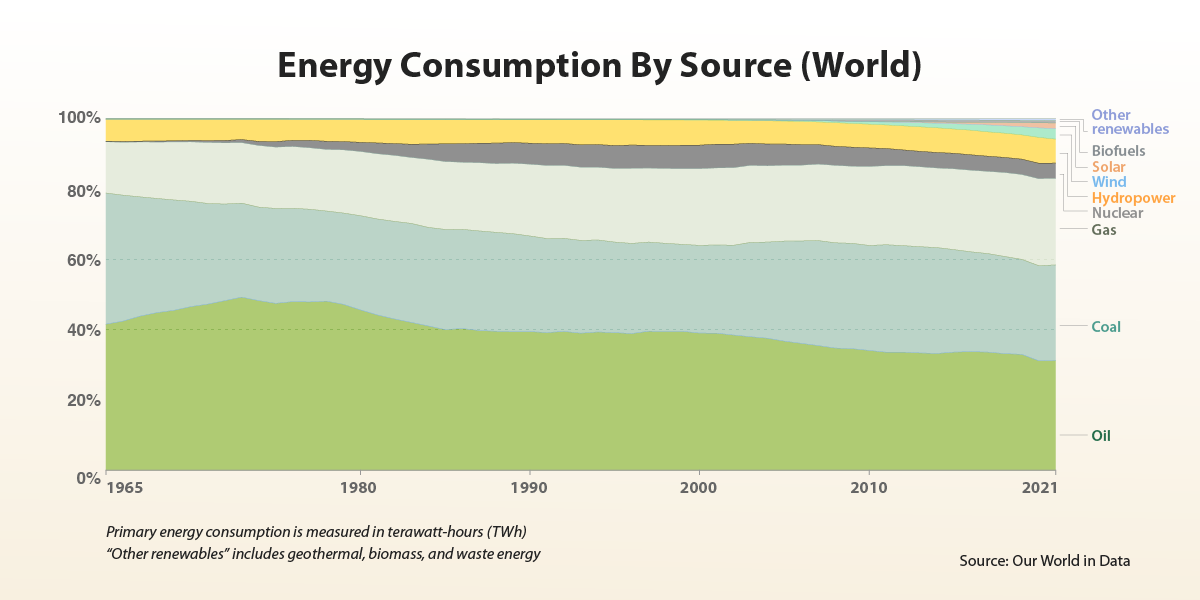
Though we have a long road ahead of us, there is hope in store. The IEA’s net zero roadmap provides a narrow but achievable scenario in which the global energy sector could realize net zero emissions, presenting solutions for how to stop climate change. This pathway contains key milestones, including no new sales of fossil fuel boilers by 2025 and electric vehicles reaching 60% of all global car sales by 2030, that aim to drastically reduce energy-related emissions. If successfully implemented, our nearly 37 gigatons of current CO2 emissions would reach net zero within the next 30 years.
The journey to a lower-carbon society more closely resembles a marathon than a sprint. But nonetheless, it is still a race. Staying on-course towards the finish line requires the widespread deployment of all available clean energy technologies, including renewables, electric vehicles (EVs), and energy efficient building retrofits, between now and 2030. Just as a rising tide lifts all boats, the interventions put in place to offset the harmful effects of climate change must offer sustainable, holistic solutions for the good of communities, countries, institutions, and Earth.
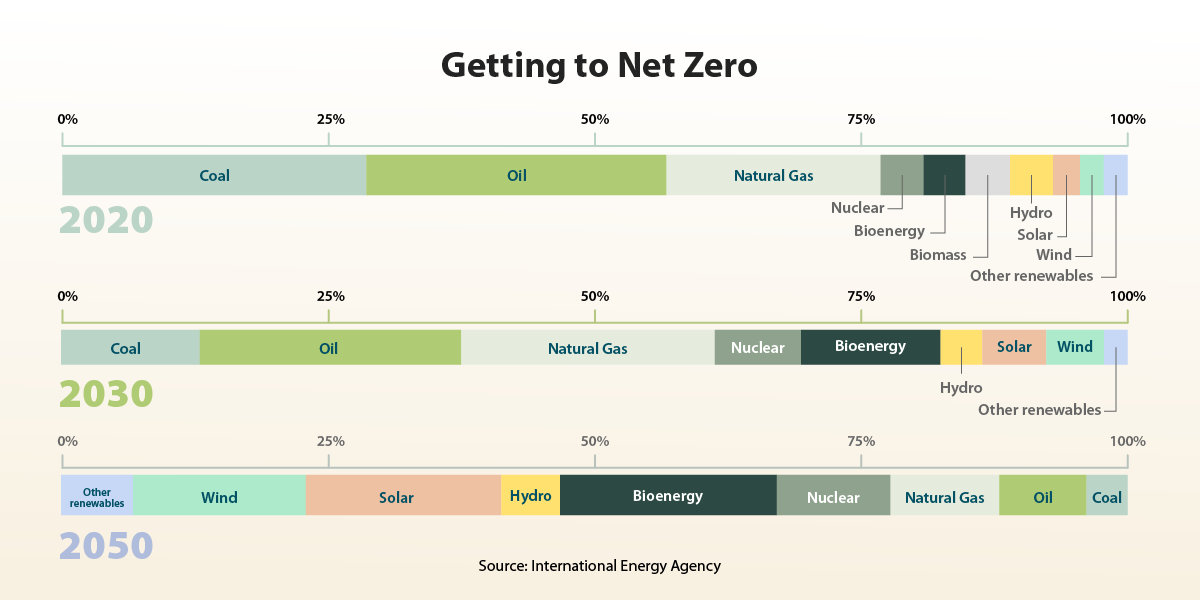
Green Technologies Powering the Future
Amongst the plethora of existing and emerging decarbonization technologies, renewables still hold the key to achieving net zero. Many of these energy sources already have a presence in our daily lives such as hydropower, which dates back as far as 200 BC, and ocean energy, which uses waves and currents to produce electricity. Other common renewable energy sources include biomass produced from a variety of organic materials such as wood, and geothermal energy produced from the Earth’s interior. But moving forward, the benefits provided by solar, wind, and hydrogen energy technologies are expected to play a more significant role in achieving a zero-emissions scenario.
Solar Energy
Solar energy is the most abundant energy resource on Earth. Accordingly, direct solar energy can significantly contribute to the energy mix for every country, despite the differing amount of daylight hours between geographical regions. The plummeting cost of solar panels in the past decade has also made solar a particularly attractive renewable energy solution. But how much do solar panels cost? Of course, solar pricing varies by region, but a report from the International Renewable Energy Agency (IRENA) shows that the prices of solar power remains cost-competitive amid the high costs of fossil fuels.
Solar power offers a number of advantages when it comes to building renewable infrastructure as well as strengthened energy security. Solar panels can be integrated into buildings and standalone structures in cities as well as retrofitted onto existing structures. They can also be used to power small sites such as bus stations and larger areas like whole communities by providing energy for microgrids. When the main electricity grid fails, microgrids keep the lights on and the electricity flowing. The independent nature of these systems makes them an excellent fit for remote areas as well. In addition to microgrids, solar energy has also proven itself as a crucial component in fortifying energy resilience during natural disasters. Nations are even considering building solar power stations in space as a solution to lowering carbon emissions.
Wind Energy
For centuries, we have been using wind to sail ships and power mills, making it one of the oldest forms of energy on record. This time-trusted source is still making a major impact in the modern age and shows no signs of slowing. Wind energy generation suits a variety of landscapes, from rural areas and farms to coastal communities and even offshore. Wind energy is easily integrated in remote areas or island communities where high-quality wind sources are often found. In addition, land-based, utility-scale wind turbines have become one of the lowest-priced energy sources available. Wind energy’s cost competitiveness is expected to continue to improve with further advancements in technology. It is also helping build communities. The Global Wind Energy Council (GWEC) has reported that wind will power 3.3 million new jobs throughout the world in the next five years due to major industry expansion.
Hydrogen
Hydrogen has become a topic of great interest in the green energy sphere, especially for its potential fuel applications in hard-to-abate industries such as long-range ground mobility, maritime shipping, and aviation. However, hydrogen isn’t only used as fuel; it can also be used as storage. It is an excellent answer to the intermittent nature of solar and wind energy as hydrogen allows vast quantities of clean energy to be stored for long durations. This energy can then be used during peak demand.
Projections show that hydrogen could contribute more than 20% of annual global emissions reductions by 2050, and increased momentum has only accelerated both investment and project development in the hydrogen technology sphere. One such technology is H2GT, or hydrogen to gas turbine technology. With H2GT, existing LNG-fired gas turbines can be retrofitted to run on up to 65% hydrogen fuel by volume. By converting these grids into mixed combustion systems, H2GT can help to prevent the energy systems of today from becoming the stranded assets of tomorrow.
Energy Storage Systems
Coupling smart green energy resources with additional storage technologies, such as energy storage systems (ESS), is essential for achieving net zero as they make it possible to integrate renewable energy into the power grid. Without storage, communities would not be able to efficiently manage the dynamics of electricity supply and demand. But by storing excess renewable-generated energy for later use, ESS can bolster green energy infrastructure and stabilize electricity supply. These systems can be used in both residential and utility-scale settings, making them a powerful tool in amplifying the effects of various renewable energy resources.
Carbon Capture
Carbon capture, utilization and storage (CCUS) is another suite of technologies that shows promise in helping us reach climate targets. CCUS involves capturing the CO2 as it is produced by factories and power plants or even directly from the atmosphere. The CO2 can then be compressed for use or fed into geological formations that can permanently trap it. In theory, this kind of system sounds great. However, CCUS has its limitations, and trapping CO2 doesn’t necessarily lead to a decline in emissions if it isn’t accompanied by a lowering of overall carbon intensity. At the current stage, despite its ability to provide the foundation for carbon removal, CCUS requires further development to be implemented on a large scale. However, experts predict it will play a significant role in achieving and maintaining net zero as the technology evolves.
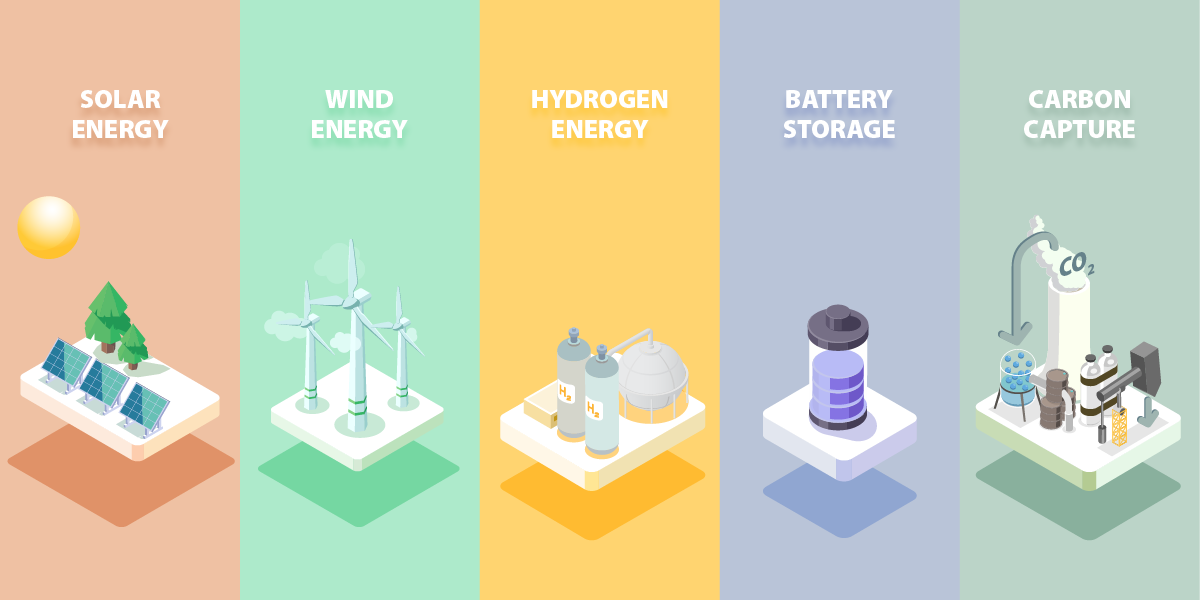
Energy Solutions for Every Corner of Earth
While these energy solutions are instrumental in decarbonization, there isn’t one perfect combination that can be successfully implemented in every location. Each country’s unique infrastructure and environment must be taken into consideration when exploring the resources that will make up its optimal energy mix.
Let’s take wind turbines, for example. This energy solution is an excellent fit to make up a large portion of the energy mix in breezy Britain as the country pursues decarbonization. However, it would be a poor choice for the still areas of Cameroon where heavy winds are few and far between. Solar panels would be incredibly successful as a clean power solution in sunny Arizona, but would yield less-than-desirable results in Norway, where certain places go without sun for a quarter of the year.
A sustainable, effective energy mix exists at the nexus of energy needs and the natural resources available in any geographical location. Costa Rica harnesses its expansive network of waterways for hydropower, generating 73.4% of its energy from this renewable resource. Iceland, contrary to its name, is abundant in geothermal heat, which the country uses to generate warmth for every home. Offshore wind power in the North Sea has the potential to meet current electricity demand in Europe six times over. The sunny skies above North Africa and the Middle East show world-leading solar power potential. As we progress on the pathway to net zero, it is critical to ensure that targets, policy interventions, and incentives all take into account geographic, political, economic, environmental, and developmental differences in charting the best course.
Stepping Into Sustainability
Fossil fuels aren’t going to disappear tomorrow, but they don’t have to. We can reach decarbonization targets by rapidly and ambitiously implementing the technology we have today on a vast scale. However, achieving net zero means leaning into a more nuanced vision for the future of energy, evaluating needs against resources, and implementing solutions accordingly.
From deserts to oceans, and valleys to mountaintops, there are multitudes of opportunities to turn the resources that surround us into the energy that sustains us. Net zero is possible, and with the optimal energy mix, we can look forward to a new era of energy that will support a healthy, thriving planet for years to come.
Get the latest news about Hanwha, right in your inbox.
Fields marked with * are mandatory.
- Non-employee
- Employee


